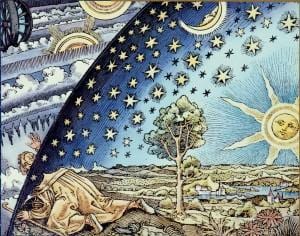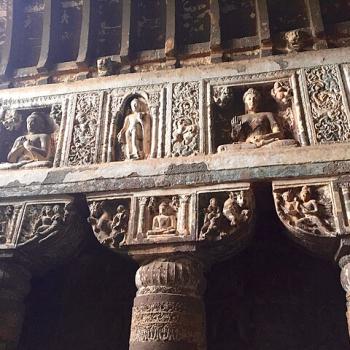Recently I stumbled upon, or really, re-read an interesting offering from the late independent philosopher and spiritual commentator, Alan Watts. In one longish sentence, he summarized his personal spiritual perspective. “If I am asked to define my personal tastes in religion, I must say that they lie between Mahayana Buddhism and Taoism, with a certain leaning toward Vedanta and Catholicism, or rather the Orthodox Church of Eastern Europe.”
As I read this, I felt profound resonances with his view of what was useful and true among religions.
For me the list would be similar, but, of course, as it is my way, slightly different. Zen Buddhism, with sympathies going to Taoism and Western (writ large) Christian mystical traditions, particularly aspects of Eastern Orthodoxy, but mostly Anglicanism, all washed through a profoundly rationalist and naturalist sensibility.
I then published the two summary statements on Facebook along with an invitation for others to share their own sense of that matter. As I write this there were 91 comments. Most included their own list of how they engaged the world, each blending in some way from the world’s traditions, science, and philosophy. There were also cautions, and some outright disdain. One friend suggested this sort of listing of one’s influences as a perfect example of a capitalist mentality. Others found the lists to be examples of “Sheilaism.”
Sheilaism is a term I hadn’t heard in a while. It comes from an important survey of religion in America, Robert Bellah’s 1985 Habits of the Heart. The subtitle was “Individualism and Commitment in American Life.” The book, which I read a few years later in seminary, explored the impact of religion, and especially privatized religion, and its influence on American culture. I was so impressed that I wrote him a note asking if he would be a reader for my upcoming Master’s thesis.
I was at the Pacific School of Religion, which was part of the Graduate Theological Union, which had formal ties to the University of California, Berkeley, where he taught. The campuses touched. He invited me to visit with him at his office. After discussing my project, which was to be an exploration of the establishment of Zen in North America, he agreed. Sadly, I was unable to proceed with that project for my thesis, and so never got to work with him. But I’ve never forgotten his kindness. Nor, Habits of the Heart.
As to Sheilaism. Among the case histories the book examined was a young woman, who they gave the name “Sheila.” In describing her faith stance, she said,
“I believe in God. I’m not a religious fanatic. I can’t remember the last time I went to church. My faith has carried me a long way. It’s Sheilaism. Just my own little voice … It’s just try to love yourself and be gentle with yourself. You know, I guess, take care of each other. I think He would want us to take care of each other.”
Basically, Sheilaism is cafeteria religion. Or Salad bar religion. It is religion where one picks what one likes and ignores the rest. And a glance at the various lists provided among the 91 offerings, starting with Watts, and including my own, it’s easy to see pretty much all of them, us, as sharing pretty obvious examples of pick and choose religion.
What Bellah and his associates saw in Sheilaism was run away individualism. Not entirely bad, but definitely dangerous. It also strikes me that Sheilaisim is an early manifestation of the sentiment we capture as “spiritual but not religious.”
One writer speaks of this privatized religion as “spiritual bricolage.” Bricolage is a term in art for a creation drawing upon various elements. Sort of found art. As with art in general, where there’s a lot more bad art than good, bricolage in religion is more commonly pretty bad stuff. Not well thought through. Often things don’t hang together. Too often simply self-justifying.
In matters religious, taking what feels good as the only metric, rarely works for the long haul. When one gets cancer, it fails.
And bricolage can be great art. I believe it also can be authentic spirituality. The difference lies in mysterious elements, a sense of harmony, an eye for color. It is informed by some sense, but not a totally private sense of what fits.
The issue really is more a matter of understanding what the fundamental questions are, how we fit into them, and where do we proceed from that understanding?
Like with art, our spiritual lives are about something that is at once ineffible and as physical and real as can be.
And what is soul satisfying is spirituality that serves in good times and bad. And, which puts us on a path to ever greater depth. To, well, who knows what the ultimate end of the matter is. But it is filled with words like nirvana, heaven, the promised land.
Or, the one I find constantly calling: intimacy.
So, probably we need something solid to start with.
For me, when pushed, I see that Buddhism, Zen, really is the deep root. For me the four marks of existence are pretty much axiomatic.
But the traditional religions are also flawed things. Like all things, broken. And sometimes, especially I modernity, we have access to correctives. The found objects are numerous, as numerous as the world’s religions and philosophies.
So, I also dream Christianity. It is my natal tradition. The gathering of people in a sacred meal where we are invited to eat and drink can be an astonishing invitation into the most intimate of intimate things. And, I see how Judaism in particular offers a challenge to any private religion. We are, ultimately, bound up together, and that image of exodus and a communal movement from bondage to freedom becomes a really important corrective to the essentially privatized sense of personal enlightenment.
So, pick and choose.
But be careful.
A lot rides on what we choose.













